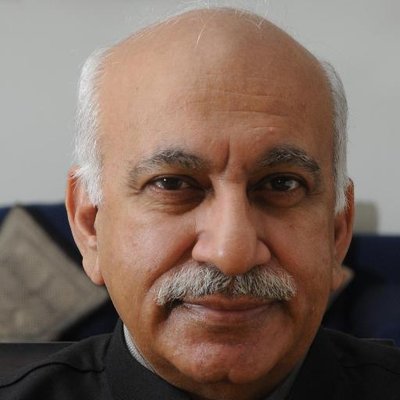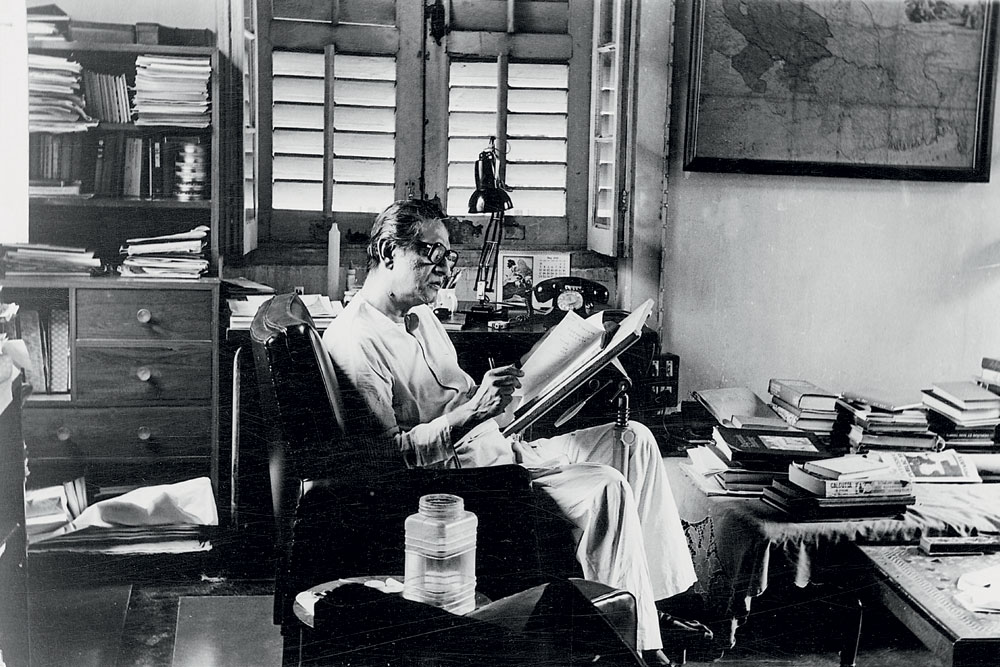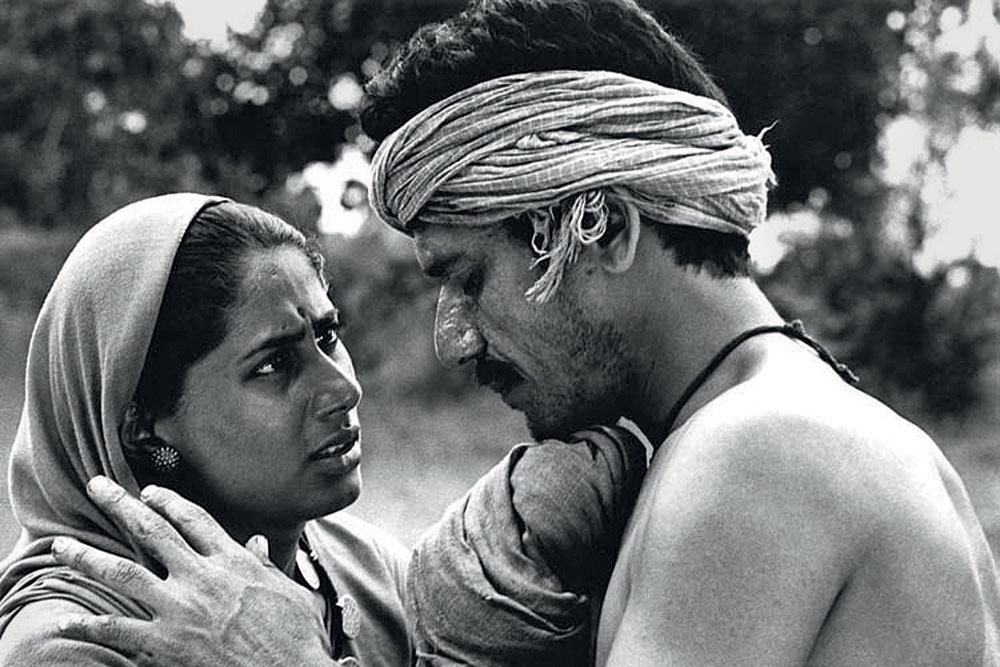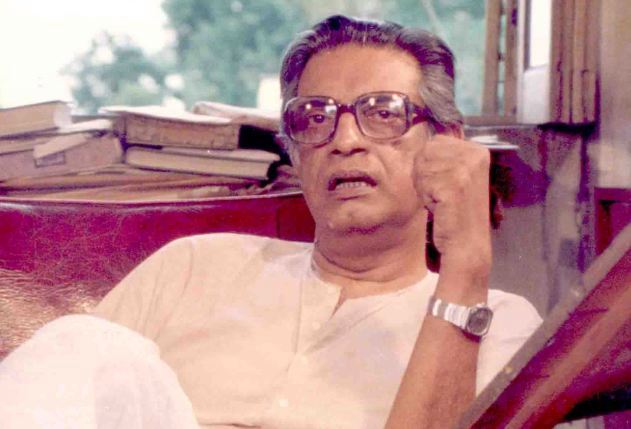From Genius to Divinity : MJ Akbar, remembering Satyajit Ray

Satyajit Ray never touched alcohol, and listened to a sonata by Beethoven on his turntable gramophone at breakfast. What else could possibly be required for the biodata of a Calcutta god?
The genesis and incubation of deification used to follow the law of multiple sources in the Calcutta of the 1970s and 1980s. A combination of stray stories raised you, tale by tale, on to the pedestal. The stories did not have to be facts, since they came with decorative embellishments by the storyteller; they merely had to be credible. Credibility was anchored in genuine, indisputable achievement; but once that had been established then the grey area of allusion, some invention by name-droppers, and the genuine anecdotes of sincere devotees transformed genius into divinity.
and incubation of deification used to follow the law of multiple sources in the Calcutta of the 1970s and 1980s. A combination of stray stories raised you, tale by tale, on to the pedestal. The stories did not have to be facts, since they came with decorative embellishments by the storyteller; they merely had to be credible. Credibility was anchored in genuine, indisputable achievement; but once that had been established then the grey area of allusion, some invention by name-droppers, and the genuine anecdotes of sincere devotees transformed genius into divinity.
The shelf life of some luminaries was pretty short. Many wobbled on the slippery perch of moderately priced alcohol. Others imploded after a premature leakage of talent. The one genius who could do no wrong as his fame broke through in the 1950s and enveloped the rest of his life was the unique Satyajit Ray.
A great Bengali had broken the international celluloid ceiling, and done so with nothing but a mind full of images, a satchel full of sketches, a handful of friends, and a pocket short of cash. He was a director who had never directed a scene until he began his triumphal debut Pather Panchali, along with a cinematographer, Subrata Mitra, who had never filmed a movie scene. Their only serious equipment was a borrowed 16mm camera. The background music was by a fellow Bengali, Ravi Shankar, whose score was based on classical ragas. Its international premiere in 1955 was at New York’s Museum of Modern Art, and it won awards at Cannes, Berlin, the royalty of class cinema, quite distinct from the crass of Oscar.
Satyajit Ray never touched alcohol, and listened to a sonata by Beethoven on his turntable gramophone at breakfast. What else could possibly be required for the biodata of a Calcutta god?
It was the sonata that put the ideal idol beyond reach of criticism in the city of small salons.
Adulation was never stained, or strained, by doubt. The sniffy cognoscenti might be aware that François Truffaut, daddy of the New Wave, found Pather Panchali a bit dull. There is no record of whether Truffaut saw it again, although he changed his mind after the awards arrived. The literary circles of Calcutta had no time for Truffaut on Ray; they were entranced by the story of the famous French filmmaker who wandered the streets of Paris through the night after seeing the film, trying to assimilate the art he had witnessed. At this distance, I cannot recall his name; but that was the story that frequently bubbled up in conversations about Ray.
Ray’s letter led to my only one-on-one meeting with him, in his apartment at 1/1 Bishop Lefroy Road. Ray was kind, without being patronising; my knowledge of cinema was infantile, and his interest in politics was perfunctory
It was important to Calcutta that the homage was by a Frenchman. Praise by a Hollywood filmmaker would have been passé. But adoration from France was of a special genre. Calcutta might have been the most lasting contribution of British colonialism to international geography, but for Calcutta intellectuals of the 20th century, their city was a Paris of the East. They might have had only a vague idea of what Paris of the West was all about, since no one knew French; but there were enough translations of Sartre, Camus and Jean Anouilh in the city’s bookshops as evidence.
It helped that Ray started his career in advertising; his admirers were good at spreading the word. Calcutta was India’s advertising hub before Naxalite violence began to dismember the city from the middle of the 1960s. Mumbai was an also-ran, scrambling anxiously for ideas within nouveau riche pots of money. Calcutta was the real thing, the true home of creative talent, led by advertising aristocrats who shared their professional affluence and used their considerable influence to promote siblings in the arts. In his early days Ray worked for an advertising agency which sent him on a tour of Europe; a high investment in an individual at that time of post-war scarcity. Abroad, Ray saw films like Vittorio de Sica’s Bicycle Thieves, and his romance with cinema became a lifelong love affair.
One of Ray’s closest friends was Chidananda Dasgupta, ensconced in the plush advertising department of cash-rich Imperial Tobacco. Ray and Dasgupta, born in the same year, welcomed India’s independence in 1947 by co-founding the Calcutta Film Society. Both were Brahmos, members of the eclectic, rationalist sect started by Raja Ram Mohan Roy which believes that the high philosophy of Vedantic Hinduism has no place for idol worship. Some of the greatest names in 20th century Bengal, including that of Gurudev Rabindranath Tagore, belong to Brahmo families: Bipin Chandra Pal, Sarojini Naidu, Sir Jagadish Chandra Bose, Chittaranjan Das, Ashoke Sen, Romesh Chunder Dutt, Nikhil Chakravartty, PC Mahalanobis, Air Marshal Subroto Mukerjee, and the great Bidhan Chandra Roy, Mahatma Gandhi’s doctor and the first elected chief minister of West Bengal.

Ray’s funds dried up while making Pather Panchali. When the chips were down, his friends stepped in to save the masterpiece from the vast treasury of incomplete art. Chidananda Dasgupta spoke to Bidhan Roy, who authorised a loan of Rs 2.1 lakh from the state government, a considerable amount of money then. It is pertinent to note that the Bengal government made seven times its investment when the final returns came in. Chidananda Dasgupta, who died in 2011, was the father of the brilliant filmmaker and actress Aparna Sen.
The litmus test was the preview; if you were not invited, your status in Calcutta slipped into the cellar from the attic. Many a gentleman preferred the excuse of urgent business if an invitation did not arrive
SUCH WERE THE stories which nourished the growing aura of Satyajit Ray. For the generation that followed his work, an average of one film a year, there was much excitement at each stage of the process. The first decision by Ray was, obviously, the book to be turned into film. Sunil Gangopadhyay would laugh shyly and pay for more than his round on convivial evenings when his books were selected by Ray. Finance was not a problem after Pather Panchali; moreover, Ray was never extravagant; Calcutta’s Marwari businessmen backed him with careful enthusiasm. There was always much excitement over the cast, for everyone knew that Ray was a tough taskmaster. Even the beautiful Madhabi Mukherjee, princess of Charulata, was passed over when the first wrinkles appeared on her face, said The Man Who Knew Everything in our liquid gang. But the true litmus test was the preview; if you were not invited, your status in Calcutta slipped into the cellar from the attic. Many a gentleman in a finely woven dhuti, an inherited shawl thrown languidly across a shoulder, preferred the excuse of urgent business to be elsewhere if an invitation did not arrive.
In the last week of December 1981, we saw a short film made by Satyajit Ray based on ‘Sadgati’, a story by Dhanpat Rai (better known as Premchand) about an ‘untouchable’ called Dukhi Chamar, his wife Jhuria, their 12-year-old daughter Dhania, and the village priest, Pandit Ghasiram.
Just a few days later, on the night of December 30th, 1981, unarmed and helpless Dalits were massacred in a village called Sarhupur by killers who had first been invited to a feast and then sent on to kill innocent men, women and children with automatic guns. There was no logical reason for this outrage, but there was a senseless one: caste violence.
It helped that Ray started his career in advertising; his admirers were good at spreading the word. Calcutta was India’s advertising hub before Naxalite violence began to dismember the city from the middle of the 1960s. Calcutta was the true home of creative talent
I went to the site to do a report for the magazine Sunday. It struck me that reality might be placed in better context if I juxtaposed Ray’s scenes from Sadgati with facts from Sarhupur, to stress how little had changed from British India’s United Provinces of the 1920s to independent India’s Uttar Pradesh of 1982, despite the existence of a Constitution full of words. (Ironically, some of the words in my report written in January 1982 might have become unconstitutional now.)
In Premchand’s story, a starving and feverish Dukhi must carry some grass to the well-nourished Pandit, to seek an auspicious date for Dhania’s marriage. For the Pandit this is an opportunity to extract as much labour from the enfeebled Dukhi as he can. He loads on tiring jobs, and then orders Dukhi to chop an obstinate tree, with fatal consequences. Let me give an instance of this juxtaposition, reproduced from my collection of reports, Riot after Riot.
ART: SADGATI, OPENING SEQUENCE
‘The calm and still soft light of a summer morning, the worry on Jhuria’s face is at odds with the freshness and serenity of the environment. She turns to her twelve-year-old daughter, Dhania, an exquisitely beautiful child, just a moment or two away from adulthood, and asks where her father is. Dhania is sweeping the courtyard; she pauses to answer that her father [Dukhi] has gone to cut some grass…even an “untouchable’s” existence has not robbed Jhuria of her innocence; she wants to borrow a cot from the headman [for the priest to sit on]! Dukhi tells her the facts of her life; she wouldn’t get a coal to light a fire with from them, not to speak of a cot. Dukhi picks up the bundle of grass, stumbles a little under the load; Jhuria runs to help him. Dukhi then tells her all she must do while he goes to fetch the Pandit. He will bring some mahua leaves, which are considered holy, and she must make a leaf mat on which the Pandit can sit, and a leaf plate on which they can keep some food as a gift to the priest. Jhuria must take the daughter of the Gond (who is touchable) to the village Sahu’s shop and ask her to buy for them all the things they need: a seer of atta, half a seer of rice, one pao of dal, half a pao of ghee, salt, haldi, and then she must remember to keep four annas in one corner of the plate. And she must remember to never, never touch anything! Nahin to gajab ho jaayega!’
REALITY: SARHUPUR, DECEMBER 30TH, 1981
‘The winter winds chill the bone in the flat land that sweeps away south from the Himalayas, adding a corrosive edge to the temperature which is hovering single digit degrees above zero. By six thirty, the sun, a late departer in the north, has finally gone down, taking away its warmth; the world is slipping through the gauze of dusk into the darkness of a night decorated with an unfathomable profusion of stars, bright but not warm…Now the shadows have become dark enough to camouflage a stranger’s face; from the haze settling over the field emerge three young men. They wear police uniforms; their faces are partially masked; one has a torch; all have guns—sophisticated weapons, including the SLR and .30 carbine. They find an old woman trudging back to the village; they ask her the way to the Dalit basti. She points vaguely in the direction, and runs away, terrified…Then they turn into a narrow lane which will take them to the basti of the Dalits, and to an appointment with murder.’

Satyajit Ray read the piece, and sent me an immaculately written letter spread across three effusive pages. It was a paean not to journalism, but to his own humanism, the essence of his value system. This was the Ray who could reach the heart and mind of rural poverty and its lacerating consequences through Apu’s life, based on Bibhutibhushan Bandyopadhyay’s semi-autobiographical novel published in 1929; the Ray who spun a memorable metaphor of political decline, social stagnation and cultural confidence on a chess table in Premchand’s unique Shatranj ke Khilari; and explored hope, ambition, frustration and failure of anonymous lives in the urban catacombs of Calcutta. Since every viewer has the right to bias, my favourite Ray film is Aranyer Din Ratri, from Sunil Gangopadhyay’s fiction.
THE LETTER LED to my only one-on-one meeting with Satyajit Ray, in his apartment at 1/1 Bishop Lefroy Road. I looked up to him, literally as well: he was six feet, four inches tall. Ray was kind, without being patronising; my knowledge of cinema was infantile, and his interest in politics was perfunctory. I was too much in awe to find my insouciant self, and coffee is not a great lubricant for the tongue-tied.
In the last week of December 1981, we saw a short film made by Satyajit Ray based on Premchand’s ‘Sadgati’, a story about an ‘untouchable’ called Dukhi, his wife Jhuria, their 12-year-old daughter Dhania, and the village priest. Just a few days later, on the night of December 30th, 1981, unarmed and helpless Dalits were massacred in a village called Sarhupur
There is something in the story related about the professional actor Kanu Bandopadhyay, who played Harihar Ray in Pather Panchali.The veteran said that he preferred his role in the popular religious movie Bhagaban Shri Ramkrishna. His reason: “In this kind of a film, people remember you. In Ray’s kind, people remember only Ray.” Satyajit Ray was quite ready to work with superstars of Bengali and Hindi cinema, if he considered them suitable for a particular role: Sharmila Tagore and Soumitra Chatterjee in Devi, Uttam Kumar and Sharmila Tagore in Nayak; Sanjeev Kumar and Amjad Khan in Shatranj ke Khilari; Victor Banerjee in Ghare Baire; Simi in Aranyer Din Ratri. Soumitra Chatterjee was the only perennial favourite. But each movie, for better or (rarely) worse was a Ray film.
Satyajit Ray also worked with Gerard Depardieu but alas not with the French star in the cast. Depardieu was one of the producers of Shakha Proshakha, made in 1990. The music was by Satyajit Ray, Bach and Beethoven. I told you about Beethoven.
I didn’t know about Bach.







